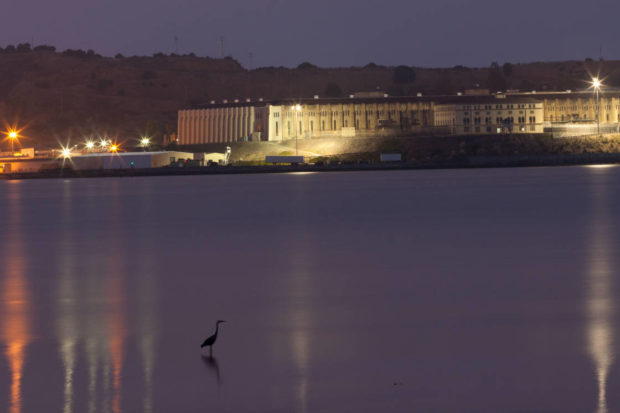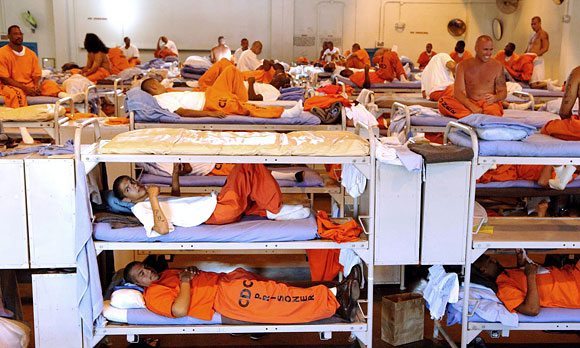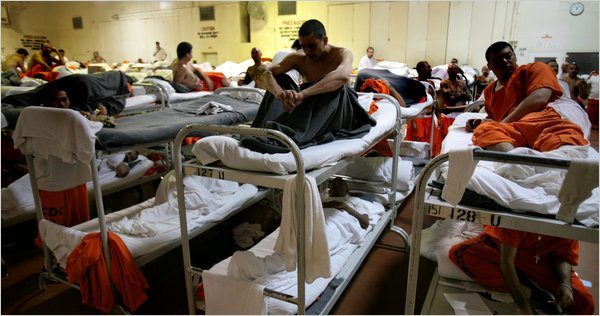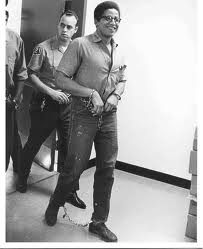
By Catherine Campbell
(Author’s note: This is part one of a two-part series on the history of the California prison boom. Part two will appear in the November issue of the Community Alliance.)

Our nation’s imprisonment of more people than ever before seems a well-known fact to most people given the shocking and demoralizing news on television, books, articles and in print during the last decades. What most don’t know is how we got here, how the Land of the Free became the land of the imprisoned. The United States locks up more of our residents than any other nation: 743 of every 100,000 people, one of every 31. Another perspective on this dizzying and disgraceful reality: With 5% of the world’s population, we lock up 25% of the world’s prisoners.
The cost of the United States’ incarceration is a devastating $200 billion a year, which depletes our collective resources at a time when the available money pot leaks as never before. This incarceration figure does not include other intangible costs, such as the impact mass incarceration has on families who lose their sources of livelihood. Each person sent off to prison, or placed onto probation or parole, becomes part of an endless cycle of state involvement: He or she is destined to reporting, surveillance and recidivism that wrecks lives.
If you are Black and haven’t finished high school, the chances are 60% that you will go to jail—an event that will greatly lessen your opportunity for employment and will, in all likelihood, ruin what remains of your life.
In California, the subject of this article, we lock up 595 of every 100,000 people. In states where governors ran for office or governed with a “tough-on-crime” philosophy, more people go to prison. It’s as simple, and as complex, as that. The governor most responsible for the expansion of prisons in California is Courten “Corky” George Deukmejian, the governor of California from 1983 to 1991. Deukmejian is known for his obscurity. He has virtually disappeared from public view, and those who would like to interview him are told he is cleaning his garage.
No biography of Deukmejian has ever been written. Apparently, he likes it that way.
Generally, California’s incarceration rate expanded after WWII, decreased during the Reagan administration and then began to climb. It peaked in 2006 when it decreased because the enthusiasm for incarceration began to wane. It is about to undergo a massive shift again when thousands of convicted persons are sent to local jails instead of state prisons—all because the Supreme Court recently said California prisons are unconstitutionally overcrowded.
Prison gyms are stacked with bodies. Getting medical care is iffy, quality of care dramatically awful. Nowhere is counseling and therapy more needed, yet it’s nearly impossible for an inmate to talk with a neutral person in confidence. People who should be single-celled are not, and cellmate on cellmate violence is watched impassively by other inmates and guards.
In a local prison, a 72-year-old Sikh priest on a hunger strike died in his cell, in front of a hundred guards and other inmates, shrunken, weighing 78 pounds. Nobody noticed. 
In prisons across the state, inmates have been shot and wounded, or killed, because of administratively sanctioned policy. Thousands of men live in security housing in solitary confinement, rarely speaking with another human being. Many just kill themselves. The California Supreme Court found that six people die a week from medical neglect. Americans are quiet, or proudly indifferent, about the torture inflicted routinely on American prisoners.
Governor Ronald Reagan was a true fiscal conservative while declaring his “tough on crime” politics. Reagan cared little if at all about the human damage of imprisonment, but he did care about the cost. The prison population during Reagan’s administration fell and reached its nadir in 1972. In 1977, the last year of the decline, California was still bucking the country-wide trend by incarcerating relatively few people, 19,600 inmates.
More men are now locked up in the Los Angeles County Jail.
The change began on a date infamous to the left, and to those who run our prisons. On Aug. 21, 1971, the politics of prisons in California changed forever.
In the end, there were six corpses, five of them stuffed into cells in the San Quentin Adjustment Center, four with throats slit, one with a bullet through his brain. The sixth body was on the yard, dead from a bullet through the back.
How people feel about the events that led to these deaths depends still, more than 30 years later, on their attachment to the corpses.
For the men who arrived on the bloody scene after the killings were over, the corpses that mattered were those of Frank DeLeon, Paul Krasnes and Jere Graham, two guards and a sergeant at San Quentin Prison. These men, unarmed and defenseless, were working stiffs, doing their jobs and walking the line for the corrections department. They were good men, family men, all in their 40s and 50s, all White, all slightly overweight, all long-term keepers of the kept. That they were largely racist, too, and had anti-inmate attitudes, that was just part of the job—almost everyone who worked in a California prison in August 1971 felt pretty much the same way. The attitude came with the territory; in order to cage, cuff and control people you have to hate them.
Two of the corpses didn’t matter to anyone in particular. John Lynn and Ronald Kane were two White inmate kitchen attendants who ended up dead because they were White. Lynn was still alive when guards arrived on the scene, but they ran past him in their rush to tend to their own.
 The body on the yard, the body of George Jackson, charismatic prisoner revolutionary and author of Soledad Brother, mattered to many people for he was the leader of the movement that was supposed to bring about the revolution.
The body on the yard, the body of George Jackson, charismatic prisoner revolutionary and author of Soledad Brother, mattered to many people for he was the leader of the movement that was supposed to bring about the revolution.
It was August 1971, and the nation was polarized over Vietnam, crime and race. The extreme injustice and moral wrongfulness of the war justified every effort to oppose it and, when nonviolent resistance appeared powerless, radical violence began to take its place. An alignment between the Bay Area left and the Black radical prisoners at San Quentin led by Jackson was forged. When Jackson died, the left cried “foul,” for it lost a revolutionary hero.
What actually happened in the Adjustment Center at San Quentin that day is still unclear and much is unknown. The official version remains the same. One of Jackson’s lawyer friends secreted a gun into the prison, Jackson hid the gun in the Afro wig he was wearing and when the gun was discovered as Jackson returned to the Adjustment Center, he let the inmates out of their cells, enlisting the Blacks in a series of murders and then, when the authorities outside the Adjustment Center began to realize what was happening, he ran into the yard headed for a fence, was shot first in the ankle and then was cut down by a bullet in his back that popped out the top of his head.
Critics of this version range from leftist conspiracy theorists who, after all, have reason to be paranoid given what law enforcement was up to in the 1960s and 1970s, to conventional prison reformers whose experience has taught them that prison guards and administrators routinely lie about shootings and other forms of brutality and feel smugly righteous about it: After all, they have an ugly job, the “toughest beat,” and they are confining the “worst of the worst,” and the man who shot Jackson is respected, whether Jackson was standing, or as these critics assume, lying on the ground because of the first shot that shattered his ankle.
Either way, Jackson was dead and the man who shot him is a hero.
The killings of Aug. 21, 1971, were the climax of a series of violent confrontations between Black inmates and White guards. On Jan. 13, 1970, a Black leader, W.L. Nolen, and two other men, were shot dead at Soledad prison near Salinas. When the shootings were later deemed justified by a grand jury investigation, a White guard was thrown from a tier at Soledad, and Jackson and two others, later dubbed the “Soledad Brothers,” were accused of the crime and were transferred to the San Quentin Adjustment Center to stand trial.
Retaliation against White police had become part of the revolutionary rhetoric and ethos. Racial tensions were at an all-time high. The political left believed Jackson had been accused of the murder to silence him and that the eyewitnesses to the murder had all been coerced into pinning it on Jackson. The rich and famous of the left joined what became a feverish crusade to free Jackson, who was suddenly an idol to adoring fans all over the world.
The clusters of participants in these events all lived in isolated, insulated contexts. The radical free left joined hands in marches on the streets of San Francisco and Berkeley and talked and fought among themselves, arguing over the finer points of the inevitable, imminent revolution that would bring down the warmongering, right-wing Nixon and Reagan governments and put “the people” back in power. Many stocked food in their basements to prepare for what they were sure was coming.
Many Black and Hispanic prisoners were convinced an armed struggle was about to occur on the streets of America and that they were the righteous vanguard of that revolution, if only they could be released to take their rightful place as leaders. Their isolation, which only increased as prison administrators reacted to events, intensified their fantasies and delusions about their place in the world. Even Jackson was increasingly isolated from anyone who could balance his world view, and his only contacts were with worshipful lawyers and highly charged romantic revolutionaries, who fed him mythic futuristic dramas of escape, control and revenge.
An equally extreme and unrealistic view of Jackson and his followers grew among prison guards and administrators. They saw the Jackson fans, and particularly his lawyers and lawyers who worked for prisoners generally (and they were growing in numbers as the prison movement grew), as communist threats to the order of the prison system.
After Jackson’s book, Soledad Brothers, was published to much critical fanfare, the liberal White middle class began to ally itself with Jackson, and prison guards and bureaucrats felt increasingly under siege. They saw in Jackson a superman manipulator capable of convincing the world that prisoners are victims first and heroic rebels against injustice next.
Prison guards had always suffered from a public image as ignorant and brutal White racists who cared little for the men in their custody. This was the way they were portrayed in literature and film, and there was truth, if exaggerated, to the stereotype.
In 1971, prison guards in California came from the lower rungs of the social pecking order, they were poorly trained for their jobs and they didn’t get paid much for long hours and deadly dull work punctuated by hostility and violence. Like prisoners, they enlivened their days with gossip and rumor and created in their isolated, insulated worlds a paranoid delusion of prisoner power completely unfettered by the obvious reality that their charges are either behind bars or under the supervision of a powerful rifle.
The anger of prison guards about the deaths of their fellow guards on Aug. 21, 1971, cannot be underestimated. On the day of the killings, they took the inmates onto the yard, tied them up and then systematically burned them with cigarettes and beat them. Jackson’s dead body was flipped over, kicked and left in the sun for almost six hours.
The officers who died that day included Frank DeLeon, an escort officer who returned Jackson to the Adjustment Center at about 2:20 p.m. Paul Krasnes, referred to as a “mean bull” by Black inmates, was the first to die. Both were tied up and taken into Jackson’s cell by unknown inmates and there, next to the body of the still living Officer Kenneth McCray, Krasnes was choked and then, when he continued to cough and pray, he had his throat slit. DeLeon was the next to die. He was dragged into the cell and his throat was slit.
Jere Graham, a tough-looking, tough-talking, military-style sergeant, was standing outside the Adjustment Center. He began to wonder what was going inside so he was let in by a fellow officer, who quickly and according to protocol locked the door behind him. Three prisoners took Graham into Jackson’s cell, where McCray was playing dead next to the bodies of Krasnes and DeLeon. McCray heard the shooting death of Graham and felt the blood from the killing pour over his body.
These facts are undisputed: Three ordinary, flawed White males died that day at the hands of prisoners, Black and brown. They are memorialized on the California Correctional Peace Officers’ Association Web site and at frequent CCPOA gatherings and political events. Outside the law enforcement community, however, their deaths are unremarked and Aug. 21, 1971, remains the day Jackson died.
Although the death of Jackson had well-documented consequences in the Bay Area left and led, finally, to the end of the prisoners’ rights movement as it was known then, the consequences flowing from the deaths of DeLeon, Krasnes and Graham were greater than is generally known. These three deaths changed the direction of California corrections on the bureaucratic inside, like an invisible and silent earthquake that continues to rumble through the lives of prisoners and prison staff today.
Next month: Governor Deukmejian and California politics of crime from 1971 to the present.
Part 2 of this article can be read here.
*****
Catherine Campbell is a semi-retired civil rights attorney.
